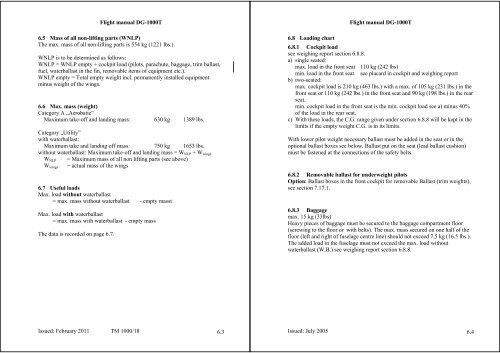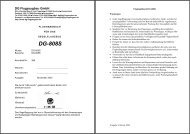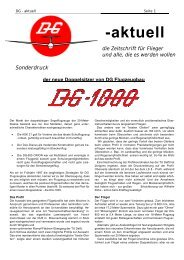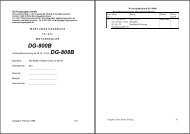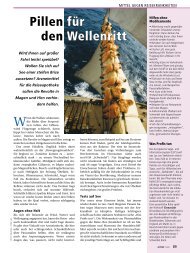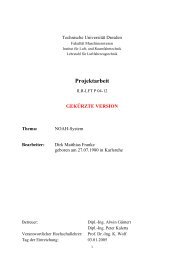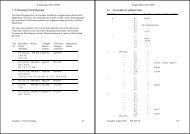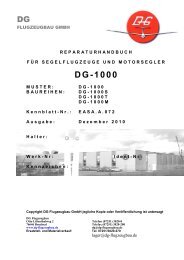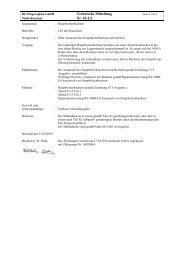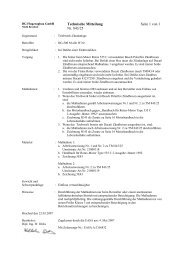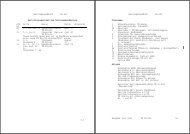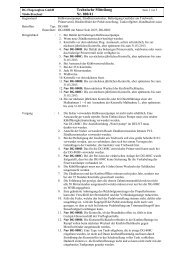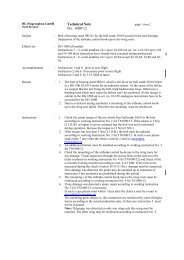DG-1000T - DG Flugzeugbau
DG-1000T - DG Flugzeugbau
DG-1000T - DG Flugzeugbau
You also want an ePaper? Increase the reach of your titles
YUMPU automatically turns print PDFs into web optimized ePapers that Google loves.
Flight manual <strong>DG</strong>-<strong>1000T</strong><br />
6.5 Mass of all non-lifting parts (WNLP)<br />
The max. mass of all non-lifting parts is 554 kg (1221 lbs.).<br />
WNLP is to be determined as follows:<br />
WNLP = WNLP empty + cockpit load (pilots, parachute, baggage, trim ballast,<br />
fuel, waterballast in the fin, removable items of equipment etc.).<br />
WNLP empty = Total empty weight incl. permanently installed equipment<br />
minus weight of the wings.<br />
6.6 Max. mass (weight)<br />
Category A „Aerobatic“<br />
Maximum take-off and landing mass: 630 kg 1389 lbs.<br />
Category „Utility”<br />
with waterballast:<br />
Maximum take and landing off mass: 750 kg 1653 lbs.<br />
without waterballast: Maximum take-off and landing mass = WNLP + Wwings<br />
WNLP = Maximum mass of all non lifting parts (see above)<br />
= actual mass of the wings<br />
Wwings<br />
6.7 Useful loads<br />
Max. load without waterballast<br />
= max. mass without waterballast - empty masst<br />
Max. load with waterballast<br />
= max. mass with waterballast - empty mass<br />
The data is recorded on page 6.7.<br />
Issued: February 2011 TM 1000/18 6.3<br />
Flight manual <strong>DG</strong>-<strong>1000T</strong><br />
6.8 Loading chart<br />
6.8.1 Cockpit load<br />
see weighing report section 6.8.8.<br />
a) single seated:<br />
max. load in the front seat 110 kg (242 lbs)<br />
min. load in the front seat see placard in cockpit and weighing report<br />
b) two-seated:<br />
max. cockpit load is 210 kg (463 lbs.) with a max. of 105 kg (231 lbs.) in the<br />
front seat or 110 kg (242 lbs.) in the front seat and 90 kg (198 lbs.) in the rear<br />
seat.<br />
min. cockpit load in the front seat is the min. cockpit load see a) minus 40%<br />
of the load in the rear seat.<br />
c) With these loads, the C.G. range given under section 6.8.8 will be kept in the<br />
limits if the empty weight C.G. is in its limits.<br />
With lower pilot weight necessary ballast must be added in the seat or in the<br />
optional ballast boxes see below. Ballast put on the seat (lead ballast cushion)<br />
must be fastened at the connections of the safety belts.<br />
6.8.2 Removable ballast for underweight pilots<br />
Option: Ballast boxes in the front cockpit for removable Ballast (trim weights),<br />
see section 7.17.1.<br />
6.8.3 Baggage<br />
max. 15 kg (33lbs)<br />
Heavy pieces of baggage must be secured to the baggage compartment floor<br />
(screwing to the floor or with belts). The max. mass secured on one half of the<br />
floor (left and right of fuselage centre line) should not exceed 7,5 kg (16.5 lbs.).<br />
The added load in the fuselage must not exceed the max. load without<br />
waterballast (W.B.) see weighing report section 6.8.8.<br />
Issued: July 2005 6.4


